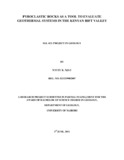| dc.description.abstract | Pyroclastic rocks when studied keenly would be a big boost to identifying the geothermal system of a
targeted area and better still a geothermal prospecting tool in potential regions, even before other surface
investigations are undertaken. It is such factors as volume and characteristics-both chemical and physical,
of these rocks that need to be looked at on a wider scope. Pyroclastics refer to tephra produced by the
expansion of magmatic gases and is a collective term for tuffs, ash, and ignimbrites (pumice-rich
pyroclasic flows). Among other factors that will be explained later, pyroclastic rocks can be used to
estimate the size of their parental chamber, indicate both host rock permeability and existence of water in
the thermal system, and reconstruct the host rock lithology and stratigraphy beneath the volcano.
This project is aimed at creating more deserved attention on pyroclastics in Kenya’s geothermal- potential
areas, most of which happen to occur in the Rift, for detailed analyses in the prospecting stages. Excellent
examples of the use of pyroclastic rocks and lithic constituents in exploration for geothermal reservoirs
are provided by studies in the Latium volcanic province of Italy, Taupo in New Zealand, and Nisyros in
Greece. | en |

